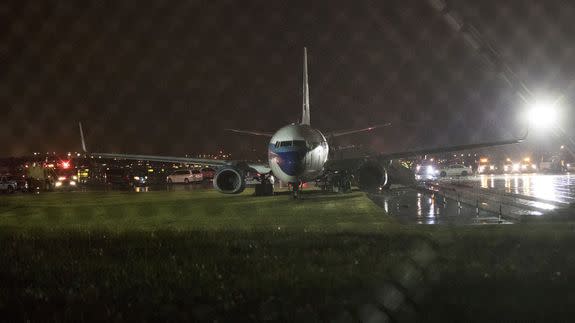The technology that saved Mike Pence's plane from disaster

It was likely a combination of technological innovation and government regulation that prevented the chartered Boeing 737-700 carrying Republican vice presidential nominee Mike Pence and his entourage from a potentially serious disaster at New York's LaGuardia Airport on Thursday night.
At an airport hemmed in by populated areas to the south and east and Flushing Bay to the north, the incident was the most prominent aviation accident to date to show the value of a modern technology known as the engineered materials arrested system, or EMAS.
The FAA requires that many airports install such systems at the end of runways in order to prevent an aircraft from overrunning a runway and plowing into homes, forests, waterways or vehicles just beyond the airport.
SEE ALSO: Mike Pence's plane skids off a runway, and everyone makes the same joke
Such incidents have happened many times before, including a Southwest Airlines flight that tore through a perimeter wall at Chicago's Midway Airport during a snowstorm in 2005. That plane, also a Boeing 737-700, hit a car, killing a child and injuring four others on the perimeter roadway.
A child in the automobile was killed, one automobile occupant received serious injuries, and three other automobile occupants received minor injuries.
PHOTO: The destroyed arrestor beds used to stop Mike Pence's campaign plane after it skidded off a LaGuardia runway https://t.co/RJ4VEkOxCB pic.twitter.com/FQ52eY7tWX
— Connor Ryan (@connortryan) October 28, 2016
With Pence's plane, though, the new technology worked as intended, and all aboard the aircraft walked away unscathed, thanks to the EMAS, which was not present on that runway in Chicago.
Think of EMAS systems as a less extreme version of an arresting hook that suddenly slows a fighter jet landing on an aircraft carrier.
At most airports where it is installed, an EMAS, which is part of a runway safety area, is about 500 feet wide and 1,000 feet beyond the end of the runway, according to the FAA. The system, which is manufactured by a New Jersey company, uses a crushable material to stop an airplane that overruns a runway.
Here's difference between runway and EMAS at end of runway 22/start of runway 4 at LGA pic.twitter.com/udA2V2p0mC
— Andrew Freedman (@afreedma) October 28, 2016
It is designed to allow the tires of the plane to sink into the material, thereby slowing the plane.
An EMAS uses crushable material placed at the end of a runway to stop an aircraft that overruns the runway. The tires of the aircraft sink into the lightweight material and the aircraft is decelerated as it rolls through the material.
According to the FAA, improvements to runway safety areas, including the use of EMAS systems and other techniques to help slow aircraft, have been made at more than 500 commercial airports, with a total of about 1,000 runways modified.
The agency claims there have been 10 incidents where EMAS technology has stopped overrunning aircraft, which would become 11 incidents once Thursday's incident is included.
Not all airports have EMAS systems, however, since some lack the land area needed to construct them. However, the FAA continues to require improvements be made regarding runway safety areas at airports around the country, with more EMAS systems and other innovations likely to come.
